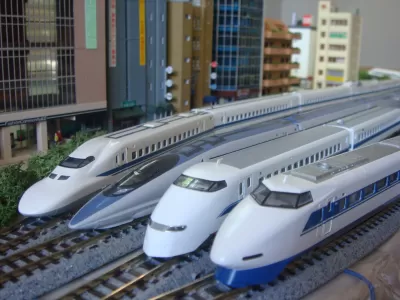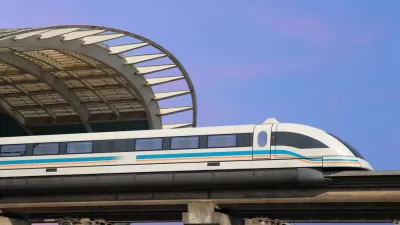Maglev high-speed rail, financed (partially) by Japan, is still under consideration for the stretch between Washington, D.C. and Baltimore. It would take a princely sum to build.

With the potential to rival airliners for speed, maglev trains are something of a pipe dream in this country. Joe Fox writes, "Superconducting maglev trains ('SCMAGLEV,' to be even more precise) are a rail technology that eschews rails, instead sitting within a concrete guideway. Trains are surrounded by superconducting magnets on each side, causing them to 'float' in the guideway."
Despite a lack of American high-speed rail savvy, backers near the nation's capital are eyeing the concept. "The Baltimore-Washington Rapid Rail (BWRR) organization held a series of open houses across the region in December to showcase the work that they have done so far, and solicit general public comment on their Environmental Impact Statement (EIS)."
The prospect of a 15-minute ride from D.C. to Baltimore is compelling, and the plan envisions an extension to New York City. But who puts up the money? "The Japan Bank of International Cooperation (JBIC) has offered to pay half the cost of the D.C.-to-Baltimore line. The remainder of the initial funding would come from a yet-to-be-identified mix of (American) federal, state, and private sources."
FULL STORY: The idea for a maglev train from DC to Baltimore keeps…floating down the track

Alabama: Trump Terminates Settlements for Black Communities Harmed By Raw Sewage
Trump deemed the landmark civil rights agreement “illegal DEI and environmental justice policy.”

Study: Maui’s Plan to Convert Vacation Rentals to Long-Term Housing Could Cause Nearly $1 Billion Economic Loss
The plan would reduce visitor accommodation by 25% resulting in 1,900 jobs lost.

Why Should We Subsidize Public Transportation?
Many public transit agencies face financial stress due to rising costs, declining fare revenue, and declining subsidies. Transit advocates must provide a strong business case for increasing public transit funding.

Paris Bike Boom Leads to Steep Drop in Air Pollution
The French city’s air quality has improved dramatically in the past 20 years, coinciding with a growth in cycling.

Why Housing Costs More to Build in California Than in Texas
Hard costs like labor and materials combined with ‘soft’ costs such as permitting make building in the San Francisco Bay Area almost three times as costly as in Texas cities.

San Diego County Sees a Rise in Urban Coyotes
San Diego County experiences a rise in urban coyotes, as sightings become prevalent throughout its urban neighbourhoods and surrounding areas.
Urban Design for Planners 1: Software Tools
This six-course series explores essential urban design concepts using open source software and equips planners with the tools they need to participate fully in the urban design process.
Planning for Universal Design
Learn the tools for implementing Universal Design in planning regulations.
Smith Gee Studio
Alamo Area Metropolitan Planning Organization
City of Santa Clarita
Institute for Housing and Urban Development Studies (IHS)
City of Grandview
Harvard GSD Executive Education
Toledo-Lucas County Plan Commissions
Salt Lake City
NYU Wagner Graduate School of Public Service




























